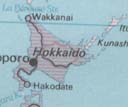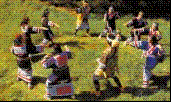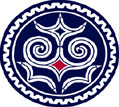Ainu
 The word ainu
means 'human'. The Ainu people are more oriented to live with nature. They also
worship their own Ainu gods, called kamuy. Hokkaido and some parts of
Honshu, both in northern Japan, are home to the Ainu. They are an indigenous
people with a distinct culture and language, but with a population of between
30,000 to 50,000 only. Some consider that pure-blooded Ainu have lighter skin,
more body hair, and higher-bridged noses than most Japanese.
The word ainu
means 'human'. The Ainu people are more oriented to live with nature. They also
worship their own Ainu gods, called kamuy. Hokkaido and some parts of
Honshu, both in northern Japan, are home to the Ainu. They are an indigenous
people with a distinct culture and language, but with a population of between
30,000 to 50,000 only. Some consider that pure-blooded Ainu have lighter skin,
more body hair, and higher-bridged noses than most Japanese.
 Ainu culture
is on the verge of collapse and to a large extent has been assimilated into
Japanese mainstream culture. The independent Ainu culture is a fading one in
which only a few can still speak the Ainu language. This is a result of government
policy from the Meiji era (1868-1912) onwards involving intense colonialism
and assimilation. There was a large shift of other Japanese northward which
resulted in near ethnocide of the Ainu. The Ainu were not allowed to speak their
own language or practice their culture which were gradually lost generation
by generation.
Ainu culture
is on the verge of collapse and to a large extent has been assimilated into
Japanese mainstream culture. The independent Ainu culture is a fading one in
which only a few can still speak the Ainu language. This is a result of government
policy from the Meiji era (1868-1912) onwards involving intense colonialism
and assimilation. There was a large shift of other Japanese northward which
resulted in near ethnocide of the Ainu. The Ainu were not allowed to speak their
own language or practice their culture which were gradually lost generation
by generation.
 The
Ainu are certainly of Japanese nationality, but of different ethnic lineage.
Still, the Ainu remain poor in comparison to other Japanese. Most Japanese tend
to look down on the Ainu. Many Ainu seek to conceal their Ainu identity. Due
to long years of marginalisation and discrimination and assimilation policies,
many of these people abandoned and denied their Ainu identity.
The
Ainu are certainly of Japanese nationality, but of different ethnic lineage.
Still, the Ainu remain poor in comparison to other Japanese. Most Japanese tend
to look down on the Ainu. Many Ainu seek to conceal their Ainu identity. Due
to long years of marginalisation and discrimination and assimilation policies,
many of these people abandoned and denied their Ainu identity.
 Others,
however, are asserting their 'aboriginal' rights. There is now a movement seeking
a rebirth of Ainu culture and reviving Ainu language and having it used in public
education through organisations such as the Utari Association. Ainu-Moshiri
is now a term used for the Ainu homelands, literally meaning 'the peaceful
land where the people live'. The 1997 'Law for the Promotion of Ainu Culture'
did not acknowledge any indigenous rights, but merely defined the Ainu culture
as an aspect of Japanese diversity - that approach is something quite different
to recognising an indigenous people.
Others,
however, are asserting their 'aboriginal' rights. There is now a movement seeking
a rebirth of Ainu culture and reviving Ainu language and having it used in public
education through organisations such as the Utari Association. Ainu-Moshiri
is now a term used for the Ainu homelands, literally meaning 'the peaceful
land where the people live'. The 1997 'Law for the Promotion of Ainu Culture'
did not acknowledge any indigenous rights, but merely defined the Ainu culture
as an aspect of Japanese diversity - that approach is something quite different
to recognising an indigenous people.
 The word ainu
means 'human'. The Ainu people are more oriented to live with nature. They also
worship their own Ainu gods, called kamuy. Hokkaido and some parts of
Honshu, both in northern Japan, are home to the Ainu. They are an indigenous
people with a distinct culture and language, but with a population of between
30,000 to 50,000 only. Some consider that pure-blooded Ainu have lighter skin,
more body hair, and higher-bridged noses than most Japanese.
The word ainu
means 'human'. The Ainu people are more oriented to live with nature. They also
worship their own Ainu gods, called kamuy. Hokkaido and some parts of
Honshu, both in northern Japan, are home to the Ainu. They are an indigenous
people with a distinct culture and language, but with a population of between
30,000 to 50,000 only. Some consider that pure-blooded Ainu have lighter skin,
more body hair, and higher-bridged noses than most Japanese. Ainu culture
is on the verge of collapse and to a large extent has been assimilated into
Japanese mainstream culture. The independent Ainu culture is a fading one in
which only a few can still speak the Ainu language. This is a result of government
policy from the Meiji era (1868-1912) onwards involving intense colonialism
and assimilation. There was a large shift of other Japanese northward which
resulted in near ethnocide of the Ainu. The Ainu were not allowed to speak their
own language or practice their culture which were gradually lost generation
by generation.
Ainu culture
is on the verge of collapse and to a large extent has been assimilated into
Japanese mainstream culture. The independent Ainu culture is a fading one in
which only a few can still speak the Ainu language. This is a result of government
policy from the Meiji era (1868-1912) onwards involving intense colonialism
and assimilation. There was a large shift of other Japanese northward which
resulted in near ethnocide of the Ainu. The Ainu were not allowed to speak their
own language or practice their culture which were gradually lost generation
by generation. The
Ainu are certainly of Japanese nationality, but of different ethnic lineage.
Still, the Ainu remain poor in comparison to other Japanese. Most Japanese tend
to look down on the Ainu. Many Ainu seek to conceal their Ainu identity. Due
to long years of marginalisation and discrimination and assimilation policies,
many of these people abandoned and denied their Ainu identity.
The
Ainu are certainly of Japanese nationality, but of different ethnic lineage.
Still, the Ainu remain poor in comparison to other Japanese. Most Japanese tend
to look down on the Ainu. Many Ainu seek to conceal their Ainu identity. Due
to long years of marginalisation and discrimination and assimilation policies,
many of these people abandoned and denied their Ainu identity.  Others,
however, are asserting their 'aboriginal' rights. There is now a movement seeking
a rebirth of Ainu culture and reviving Ainu language and having it used in public
education through organisations such as the Utari Association. Ainu-Moshiri
is now a term used for the Ainu homelands, literally meaning 'the peaceful
land where the people live'. The 1997 'Law for the Promotion of Ainu Culture'
did not acknowledge any indigenous rights, but merely defined the Ainu culture
as an aspect of Japanese diversity - that approach is something quite different
to recognising an indigenous people.
Others,
however, are asserting their 'aboriginal' rights. There is now a movement seeking
a rebirth of Ainu culture and reviving Ainu language and having it used in public
education through organisations such as the Utari Association. Ainu-Moshiri
is now a term used for the Ainu homelands, literally meaning 'the peaceful
land where the people live'. The 1997 'Law for the Promotion of Ainu Culture'
did not acknowledge any indigenous rights, but merely defined the Ainu culture
as an aspect of Japanese diversity - that approach is something quite different
to recognising an indigenous people.